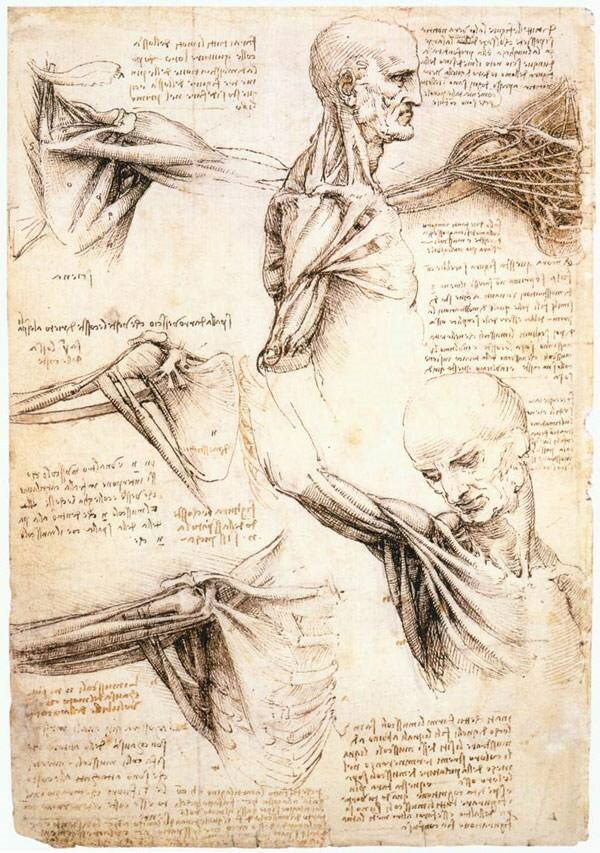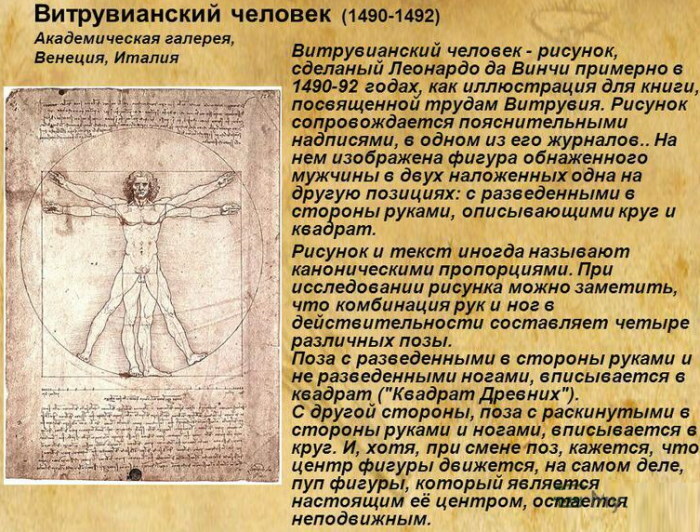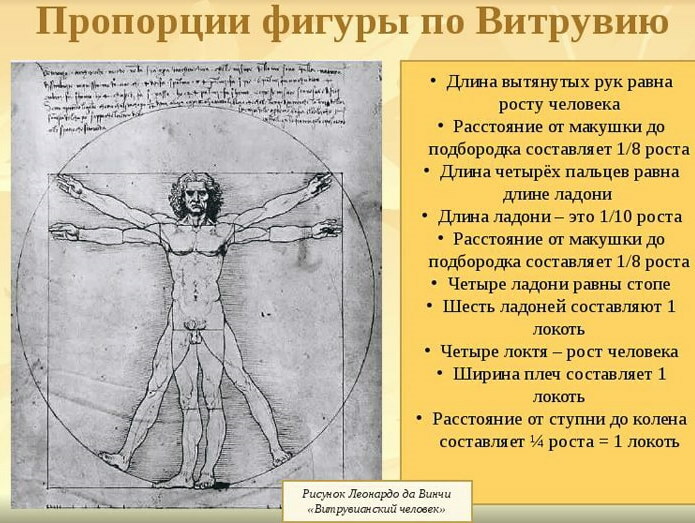Content
- Description of the figure
- Origin of the term
- The origins of the "Vitruvian Man" drawing
- Who is the creator?
- What's in the cipher?
- Why did the drawing become famous?
- Test for determining the type of figure in accordance with the theory of proportioning
- The golden ratio in ordinary and unusual things
- Interesting facts about the "Vitruvian Man" by Leonardo da Vinci
- Vitruvian Man Video
Created by the brilliant Italian thinker, inventor and painter Leonardo da Vinci, the image of a man with optimal body proportions is considered one of the most famous drawings in the world.
The ideal person is a work with a philosophical meaning, symbolizing an absolutely harmonious anthropometry.
Description of the figure
A graphic sketch is anatomical male body model with ideal parameters. Art critics consider drawing to be an obvious and visual evidence of the use of architectural laws and mathematical laws in painting.
Da Vinci's ideal man depicts the male figure with the utmost precision, observing the exact anatomical proportions. The graphic sketch, made by the author as an illustration to the works of the ancient Roman architect Mark Vitruvius Pollion, shows 2 positions of the upper and lower extremities.
The drawing is striking with anatomical accuracy and incredible realism, which are absolutely uncharacteristic of classical painting of the late 15th century.
The ideal person model contains the smallest details:
- outlines of muscle fibers;
- anatomically correct joint configuration;
- axial vertical of the spine;
- facial contours;
- outline of the skull;
- hairline.
The illusion of a three-dimensional image is formed by a carefully selected play of light and shadow. Curling hair forms a kind of halo around the face. The male body is inscribed in a square and a circle adjoining the lower parts.
The center of the first is the groin area. Researchers believe that the author in this way tried to express a homocentric view of the structure of the universe. The perfection of the contours and lines of the body is a clear allusion to the divine nature of man.
Origin of the term
At the time of Leonardo da Vinci, a person's drawing was not called Vitruvian. He received this name later in the course of researching the creativity and cultural heritage of the brilliant Italian mechanic, scientist and painter.
The term stuck to the most famous graphic sketch in history in the 18th century. The name of the model of the ideal human body is the association with the writings of Marcus Vitruvius Pollio.
The sketch was created as an illustration for a book by an ancient Roman architect, scientist and mechanic. Initially, the drawing did not claim to be world famous. It is believed that Leonardo da Vinci inspired Vitruvius's treatise "10 books on architecture" to write a graphic model of a person.
In it, the ancient Roman thinker cited the following ideal anthropometric parameters of the male body, today recognized as erroneous:
- The projection line between the end of the end phalanx of the middle finger and the base of the little finger is identical to the length of the palm.
- The span of the arms is equal to the height.
- The size of the foot is 4 palm widths.
- The interval between the lower border of the chin and the crown is 1/8 of the height.
- The width of 6 palms is identical to the distance from elbow to wrist.
- Average height is 24 palms.
- Shoulder width corresponds to 1/4 of the height.
Vitruvius in his work cited other, ideal, in his opinion, anthropometric parameters of the male body. In the graphic illustration of the Italian author, there is a deviation from the proportions and ratios indicated by the ancient Roman architect.
The origins of the "Vitruvian Man" drawing
The Italian master supposedly made a graphic masterpiece in Milan while working on the treatise "Divine Proportion". During his research, Leonardo da Vinci actively studied the works of the ancient Roman architect and mechanic Mark Vitruvius.
The author was consulted by the famous Italian mathematician Luca Pacioli, who is called the founder and theorist of modern accounting science. He is considered the greatest algebraist of the 15th century.
Pacioli's authorship belongs to the treatise "The Sum of Arithmetic" - an encyclopedic reference book of mathematical calculations. His work "Divine Proportion" formed the basis of the theory of architectural proportioning.
Da Vinci's Ideal Man is a graphic sketch influenced in many ways by Luca Pacioli. A similar drawing depicting a model of a male body from the back was found in the diary of the brilliant Italian painter and thinker of the Renaissance.
The technical data of the figure are presented in the table:
| Name | Vitruvian Man |
| Pattern type | Graphic sketch |
| Estimated creation date. | Between 1490-1492 |
| Materials (edit) | Paper, ink, pen, metallic fonts. |
| genre | Illustration |
| Modern location. | Venetian Gallery of the Academy of Arts. |
| Dimensions (edit) | 34.4x24.5 cm |
The drawing is part of a series of graphic images dedicated to the topics:
- proportional ratios;
- mathematical harmony in nature;
- symmetry;
- devices of the human body.
The graphic sketch combines the scientific knowledge of the Italian Renaissance era with the artistic trends of the time. The drawing with the author's explanations is attributed to the subject of proportional canons, which are relevant both for architecture and for anthropometry.
Who is the creator?
Many Renaissance artists tried to illustrate Vitruvius' treatises with their own images. The graphic sketch by Leonardo da Vinci is considered to be the most accurately reflecting the meaning, content and conceptual ideas of the ancient Roman architect.
The structure of the figure is not directly related to the theories set forth by Vitruvius in his treatises. According to researchers of the work of the brilliant Italian painter, the meaning and purpose of the graphic sketch are in doubt.
The work of Leonardo da Vinci does not correspond well to the idea of the ancient Roman thinker about the relationship of proportions and symmetry in architecture with the anthropometric relationships of the human body.
According to one of the hypotheses, the author of the graphic sketch may be the mathematician Luca Pacioli. Some researchers dispute the very date of the creation of the drawing, indicating 1496. Pacioli was involved in the publication of the treatise of Vitruvius, which was published in 1509. in Venice.
According to opponents of the officially recognized date and authorship of the drawing, this indirectly indicates the possibility of writing a graphic image by the famous Italian mathematician.
The sketch is considered a universal symbol of the symmetry of the human body, corresponding to the laws of the universe. This is mostly a mathematical model that is characteristic of Luca Pacioli's ideas about natural proportions.
In 2012 Italian architectural historian Claudio Sgarbi presented his own conclusions that the graphic sketch of the Vitruvian Man echoes similar studies by da Vinci's contemporary Giacomo Ferrara.
What's in the cipher?
Leonardo da Vinci became famous for his passion for riddles and secrets. Researchers of the creative heritage of the great Italian scientist and artist believe that the graphic sketch contains encrypted messages.
The male body model symbolizes the 5-pointed star, which can serve as a secret sign. In the medieval era and the times of the European Renaissance, the pentacle was perceived as a protective amulet, a magical accessory.
The rays of the 5-pointed star are the head, the arms and legs of the Vitruvian man spread apart. In a similar way, in ancient times, the ancient Roman god of war Mars, who originally led the Pantheon, was often depicted.
A human figure inscribed in a circle is found among the works of the German scientist Agrippa of Nettesheim. Some researchers believe that the 5-pointed star encoded in the graphic sketch serves as evidence of the author's interest in the occult sciences.
The ideal person is inscribed in a contiguous circle with a square. The most lively controversy in the scientific community is the question of why da Vinci chose such geometric shapes. 

In the author's diary, an entry was found on the topic of the microcosm or the world in miniature, which represents a human being. Shapes are considered basic in geometry and symbolize the mathematical laws of the universe.
Why did the drawing become famous?
The worldwide fame of the graphic masterpiece was ensured not only by the name of the alleged author. The human model with ideal anthropometric proportions is made with an uncharacteristic for the 15th century. anatomical accuracy.
This is of great interest to researchers. The image clearly illustrates the concept of perfect harmony and impeccable order. It combines the natural beauty and aesthetics of nature with the eternal thirst for knowledge.
Leonardo da Vinci is not the first artist who tried to inscribe a perfectly harmonious human body in a circle with a square. But only he succeeded in solving the problem so delicately, without violating a single proportion.
Da Vinci's genius lies in his disregard for the precise instructions given by Marcus Vitruvius in his treatise. Leonardo understood their fallacy, which other painters could not do.
Test for determining the type of figure in accordance with the theory of proportioning
The cultural and scientific significance of the masterpiece of the Italian master cannot be overestimated.
Today, the proportions presented by him act as a creative and professional guide for:
- architects;
- artists;
- graphic designers;
- fashion designers;
- designers of landscape compositions;
- decorators of interior ensembles.
Da Vinci's ideal person is a graphic sketch based on the key principle of proportioning theory, which is considered the so-called "golden ratio". Architectural objects created with its observance are perceived as absolutely harmonious.
This rule is also true for the types of the human figure. For a male physique, an average ratio of 13: 8 is applicable. It is more consistent with the rule of the golden ratio than the female figure. For the latter, the ideal ratio is 8: 5.
This proportion is manifested in accordance with the length of the shoulder and wrist, hand and fingers. The couturier's rule of the golden ratio is used in the design of clothing details. Vitruvian Man represents the ideal male body model.
Following the proportions indicated by the brilliant Italian painter allows you to form harmonious images through the correct selection of wardrobe items according to the style. The center of the circle in Leonardo da Vinci's drawing is the navel, and the circle is the pubic fusion.
The golden ratio in ordinary and unusual things
The dual measure of proportional ratios is used in anthropometric research, training graphic designers and architects. Corbusier, the founder of architectural modernism and functionalism, developed his own system of paired symmetry calculations, called the modulator.
Wildlife steadily follows the laws of aesthetics, harmony and symmetry, laid down in the formula of the golden section. Such examples are the proportions of the bodies of predatory animals and people, blossoming flower petals, shells of sea mollusks.
In compliance with this principle, the Egyptian pyramids and many modern architectural complexes were created. From the usual everyday things, you can single out the details of clothing, pieces of furniture, household appliances. They clearly observe the observance of the principles of the golden section.
Such laws are observed in:
- physics;
- celestial mechanics;
- chemistry;
- biology;
- geometry;
- physiology;
Of the unusual examples of the golden ratio, a cyclic electrical circuit is noteworthy, all sections of which have a common resistance. Oscillatory mechanisms with physical parameters proportional to the golden ratio are designed.
The most famous three-dimensional representatives of this fundamental principle of aesthetic perception in geometry are the dodecahedron and icosahedron. An example of the laws of the golden ratio are clathrate water molecules with an angle of divergence of atomic bonds of the order of 108 °.
Interesting facts about the "Vitruvian Man" by Leonardo da Vinci
The brilliant Italian painter, inventor and thinker was not going to put on public display a graphic sketch of a perfectly built man. It is believed that he created the image solely for his own research purposes.
Today "Vitruvian Man" is no less famous than other masterpieces of Leonardo da Vinci - "The Last Supper" and "La Gioconda". The sketch is just one of a series of anatomical drawings by the author.
The sitter's name remains unknown. Some researchers consider the graphic sketch a self-portrait of the brilliant Italian, others are inclined to believe that Leonardo took a lot of liberties when creating the image.
A sensational conclusion was made by the surgeon of the Royal College of Medicine, Hutan Ashrafyan. He concluded that the "ideal person" had an inguinal hernia. For a better understanding of the meaning of the picture, you need to read da Vinci's explanations to it.
Vitruvian Man Video
What secrets does the Vitruvian man hide:


